Creeping thyme is a woody, perennial species of the Thymus that acts as an excellent ground cover for sunny areas of the garden. Creeping thyme is edible like its cousin and can be used in cooking or steeped for teas and tinctures.
The thymus family encompasses a broad group of plants and herbs, all of which thrive in moderate climates. This perennial grows to a low height and then spreads out with its vine-like growing habits.
Creeping thyme has foliage with a fine texture, and they spread out across the ground, producing flowers with different shades of color, depending on the type. The vines begin to flower in the later springtime to early summer. Creeping lemon thyme, caraway thyme, and spicy orange thyme produce pink flowers, and the plant remains short, reaching a height of 4-inches.
Both pink and red creeping thyme also stay short, reaching heights of 4-inches or less. Woolly thyme can grow up to 6-inches in height, but it’s a slow developer and spreads slowly.
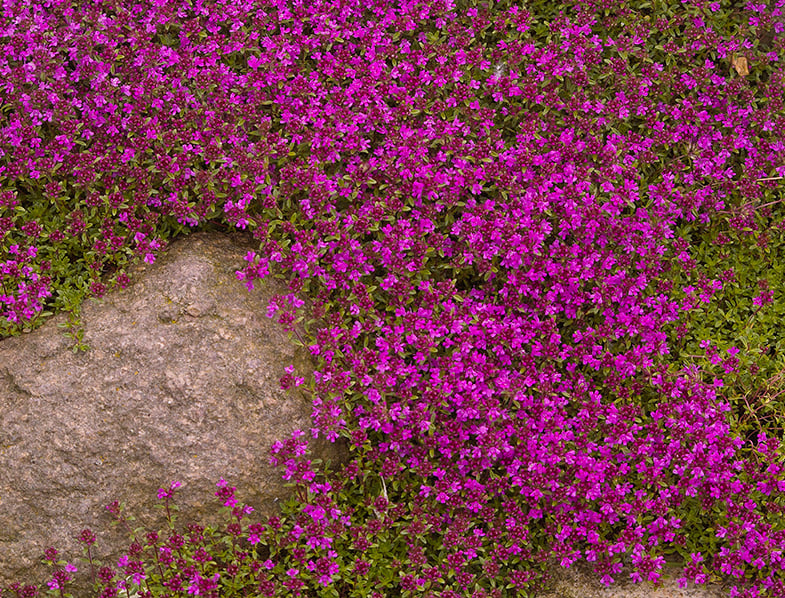
Quick Facts
| Fact | Description |
|---|---|
| Type | Creeping Thyme (Thymus) |
| Family | Thymus |
| Growth Habit | Low height, vine-like spreading |
| Flowering Time | Late spring to early summer |
| Height | 4-6 inches |
| Popular Varieties | White creeping thyme, Spicy orange creeping thyme, Red creeping thyme, Caraway thyme, Wooly thyme, Archer’s Gold thyme |
| Uses | Groundcover, landscaping, filling gaps between stepping stones, culinary, folk medicine |
| USDA Zones | Caraway thyme, creeping lemon thyme, and spicy orange thyme: Zones 5-9; White and red thyme: Zones 4-9; Wooly thyme: Zones 6-8 |
| Soil Preference | Alkaline soil with good drainage |
| Sunlight | Full sunlight or areas with afternoon shade |
| Pests and Problems | Resistant to most pests and diseases; requires good drainage to prevent root rot |
| Planting Distance | 8-12 inches apart |
| Creeping Thyme Colors | Pink Chintz, Red Creeping Thyme, Purple Carpet, Spicy Orange, Wooly Thyme, Doone Valley |
Creeping Thyme Varieties
Thyme is an indigenous plant to parts of Eurasia. However, the popularity of this plant means that it now grows in gardens all around the world. North American gardens offer ideal growing conditions for creeping thyme, with pollinators and butterflies finding the plants attractive.
Honey produced by bees feeding on creeping thyme plants near Mount Hymettus, Athens, yields a pleasant herbal and sweet flavor.
English thyme is the most popular variety of the herb, and it’s also known as garden or common thyme. It’s this variety that you use to season food.
Other varieties of creeping thyme include the following.
- White creeping thyme (Thymus paocos ‘Albiflorus’)
- Spicy orange creeping thyme (Thymus ‘Spicy Orange’)
- Red creeping thyme (Thymus serpyllum ‘Coccineus’)
- Caraway thyme (Thymus Herba-Barona)
- Wooly thyme (Thymus pseudolanuginosus)
- Archer’s Gold thyme (Thymus citriodorus Archers Gold)

Creeping Thyme for Landscaping
Creeping thyme has many uses, but it’s the best choice for groundcover for your flowerbeds. Using creeping thyme as groundcover chokes the life out of invasive weeds, keeping your flowerbeds free from weed growth.
Planting creeping thyme in your garden allows you to enjoy the sweet fragrance of the plant when it starts to flower.
Of course, there is the culinary use of the herb, but we suggest you stick with English creeping thyme if you want to use it for flavor in cooking your recipes. Creeping thyme also has a use as folk medicine, where it reduces inflammation and calms the nervous system.
- Ground Cover - Wild Creeping Thyme is a great choice to cover larger areas in the garden. It is especially sought after for populating rock gardens as well.
- Perennial Flowers - Thyme is categorized as a perennial flowering plant. The plants develop a deep root system which allows them to return the year after they initially grow.
- Easy to Establish - Simply toss the seed down to the surface of the soil and give them a good watering each day. Before you know it the tiny sprouts will be appearing all over the garden.
- Smells Great - Thyme is a very sought after herb due to its strong scent. If the leaves and stems are crushed, the smell of Thyme can deter mosquitos.
- Quality - All Thyme seeds packaged by Seed Needs are intended for the current and the following growing seasons. All seeds are stored in a temperature controlled facility that is free of significant amounts of moisture.
- Beautiful Ground Cover - Creeping Thyme (Thymus serpyllum) is an evergreen perennial with a dense, hardy growth habit. It produces a beautiful live carpet of tiny, aromatic plants with green leaves sweet scented lilac flowers that attract pollinators when grown outdoors.
- Low Maintenance & High Rewards - This versatile plant is excellent for covering spaces between stepping stones, as a lawn alternative, or for cascading down walls or containers. Creeping thyme thrives in poor soil and can even be grown in a rock garden.
- Sustainable Living - Gardening is an essential part of a self-sufficient lifestyle. Creeping Thyme's vibrant colour, fragrance, and ability to tolerate a variety of growing conditions make it an excellent choice for enhancing the beauty and diversity of your home garden.
- The Info You Need to Grow - The creeping thyme seeds for planting are packed in a beautiful paper packet with instructions for successful growing and germination in your home garden. Directions for saving seeds after harvest are also included, making it simple for beginners and experienced gardeners alike.
- Small American Family-Owned Business - We are committed to providing fresh, high-quality creeping thyme seeds for you to plant now or store for future growing seasons. Our non-hybrid, non-GMO heirloom seeds are open-pollinated, untreated, and tested for the best germination rates.
- Creeping Thyme Thymus Serpyllum is a robust, hardy perennial subshrub native to Europe and North Africa. Creeping Thyme seeds can be started indoors 6-8 weeks before last frost or directly outdoors in spring.
- These seeds are very tiny so it's best to use the shaker method and mix your seeds with sand to spread, or mix your packet with 4 cups of peat and spread in your garden area. Thyme likes moist soil while germinating so don't let your soil dry out (water from below and cover pots with plastic wrap). These germinate very slowly and the difficult part is keeping them cool, moist, and exposed to light (during the day) for 30 days.
- Or keep your pot/tray (with holes in the bottom) in a tray containing about 1" of water and cover lightly with plastic wrap. Keep your pot/tray under lights until germination. Thyme need a cool and moist environment to germinate.
- Plant type: Perennial.Germination lighting: Light.Germination days:21-30 days.Maturation days:60 days.
- Made in USA - It makes excellent for moms, adults and gardening box for men. Share with your family and friends its happiness from germination to flowering and fruiting.If the package is damaged, in insufficient quantity, or can not germinate, please contact us to replace it for you.
Last update on 2024-10-04 / Affiliate links / Images from Amazon Product Advertising API
The short and stocky nature of creeping thyme makes it the ideal choice for adequate ground cover, and some gardeners may even use creeping thyme as an alternative to grass in the yard.
However, the majority of gardeners use creeping thyme to fill in the gaps between stepping stones in pathways, or empty spaces in the yard. It’s important to note that caraway thyme may proliferate, suiting landscaping purposes where the garden requires broad coverage.
Wooly thyme is an excellent choice for tight spaces in the yard that need some ground cover. This slow-growing variety won’t engulf your stepping stones in the same manner as fast-growing varieties.
Planting white and red creeping thyme produces a spectacular visual display in the garden when they start to bloom.
For those gardeners with a scent garden, creeping thyme adds a delicious fragrance and aroma to the garden as it starts to flower. Use the creeping thyme as a border around flowerbeds, or as ground cover around tall perennials and shrubs.
When the plants are flowering, all they need is a light brush against them to release a powerful and pleasing fragrance into the air.
Cooking with Thyme
Thyme is a popular herb used in cooking. The aromatic herb brings flavor and fragrance to meals like soups and stews, and it’s a favorite additive in some olive oil blends as well. If you intend on growing creeping thyme to meet your culinary needs, then it’s important to note that both fresh and dried thyme has plenty of uses in recipes.
If you plan on drying your thyme leaves, then wait until the plant finishes flowering in the early fall. Harvest the new growth after the blooming period ends, and make sure you do it in the early morning to retain the full flavor and fragrance of the leaves. It’s essential to wait until any dew evaporates from the leaves before you harvest.
After harvesting the springs, bunch them together and hang them in a cool, dry place in your home, such as the attic. After the sprigs dry out completely, store the leaves in an air-tight container, preferably in the fridge. Fresh herbs lose their flavor and aroma after a few months, so make sure you use it within this time frame.
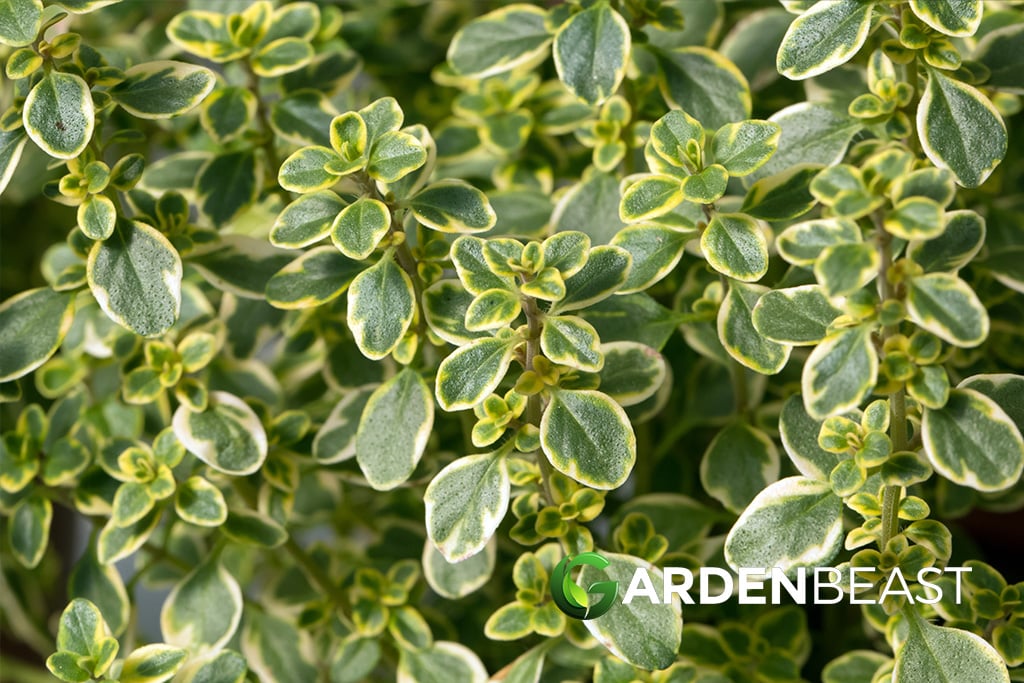
Tips for Growing Creeping Thyme
Caraway thyme, creeping lemon thyme, and spicy orange thyme, suit gardens, and growing environments in USDA zones 5 to 9. White and red thyme suit zones 4 to 9. Wooly thyme prefers USDA zones 6 to 8.
Creeping thyme grows best in soil with an alkaline balance, and it’s essential to plant your creeping thyme in an area of the garden where the ground gets good drainage. Similar to other herbs, creeping thyme doesn’t require a nutrient-dense soil. The perennial grows readily in the full sunlight, or in areas of the garden that receive afternoon shade.
Over time, your creeping thyme will develop woody stems.
If these woody stems start to dominate the plant, then it’s best to remove the plants and replace them with a new variety, pruning back the plant stimulates growth.
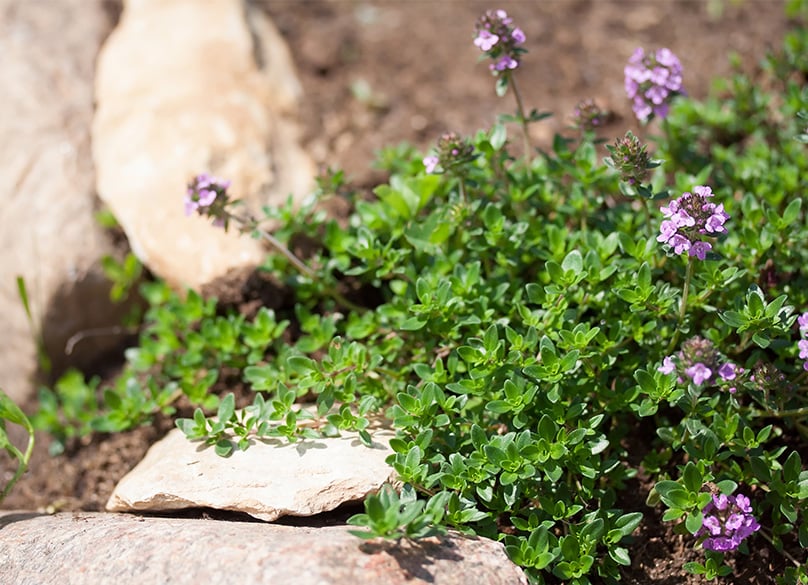
Pests and Problems
Surprisingly, thyme is resistant to most pests and diseases affecting other flowers, vegetables, and herbs in the garden.
However, gardeners must ensure they plant the creeping thyme in soil with good drainage. Leaving the roots of the plant damp all the time results in the onset of “wet feet,” and the start of root rot in the plant.
Planting Creeping Thyme
As mentioned previously, creeping thyme doesn’t require much attention while growing. Since the plant is reasonably compatible with most growing conditions, it doesn’t require excessive monitoring and watering like other perennials.
The creeping thyme does well in any soil type, but for optimal growth, plant it in nutrient-dense, loamy soil that drains well. Check the ground using a pH meter before you plant; the soil should have a slightly higher alkaline content.
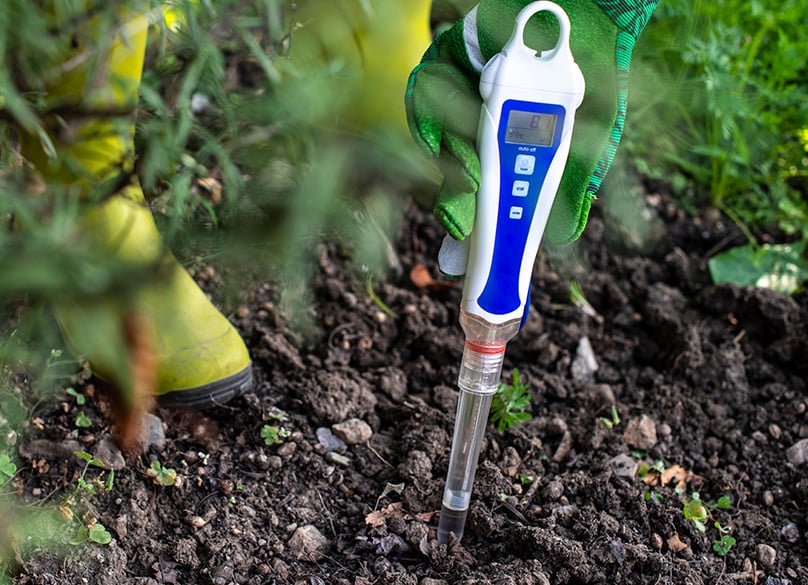
It’s possible for gardeners to propagate creeping thyme using cuttings from the stem of the plant. If you’re looking for a new plant, then you can find them available at most nurseries or garden centers.
Gardeners should take cuttings from the plant in the early summer. If you’re growing the seeds, then start them indoors in the early springtime. As the seeds sprout, you can sow them in the garden during the spring after the lasts frosts fall. Check your local listings for details on frost dates in your area.
Gardeners should plant their creeping thyme at least 8 to 12-inches apart to accommodate the spreading of the plant. Prune back the vines in the early spring to prepare the plant for the growing season ahead. Prune again after the flowers die back.
Creeping Thyme Colors
Creeping thyme comes in a wide selection of varieties, each with unique characteristics and colors.
Here are a few of the favorite types found in gardens across the United States.
- Pink Chintz – As a variety related to the genus thymus sepyllum, the pink chintz creeping thyme features dark-green, fuzzy leaves with pink flowers in light and dark hues. This creeping thyme spreads quickly and can reach diameters of up to 24-inches.
- Red Creeping Thyme – This variety of creeping thyme also goes by the moniker, “coccineus.” This variety of creeping thyme bursts into bloom with magnificent magenta flowers. This variety covers ground quickly, growing to 18-inches in diameter. The red creeping thyme produces small but pretty flowers that produce the typical thyme scent.
- Purple Carpet – This variety is the most popular type of creeping thyme found all over the world. The purple carpet grows at a low height, creating a purple carpet of flowers that gardeners can walk on without damaging the plant. This variety spreads out to 18-inches in diameter.
- Spicy Orange – This variety of creeping thyme produces pink clusters of flowers and needle-shaped foliage. This type does not provide the same groundcover effect as the purple carpet or other variations. It’s one of the smaller varieties, only spreading to a diameter of 10 to 12-inches.
- Wooly Thyme – This variety features silver-green foliage that takes the shape of a spiral. This variety is very drought-resistant, and the leaves are the focal point of the plant, although it does produce small purple and pink flowers in the summertime. This variety prefers colder climates.
- Doone Valley – Featuring light pink to purple flowers and dark-green foliage, the Doone Valley creeping thyme shows gold tips at the end of the leaves in colder climates.
Conclusion
Creeping thyme is a versatile and attractive ground cover plant that not only adds visual appeal to gardens but also offers various practical uses in landscaping and culinary applications.
With a variety of vibrant colors and unique characteristics, creeping thyme is an excellent choice for filling gaps between stepping stones, suppressing weeds, and creating a pleasant aroma in your garden. It’s also used in cooking and folk medicine, making it a valuable addition to any home garden.
By planting creeping thyme in well-draining, alkaline soil and providing it with adequate sunlight, gardeners can enjoy its beauty and utility for years to come.
Creeping Thyme FAQs
Does creeping thyme come back every year?
Yes, creeping thyme is a perennial plant, meaning it comes back every year. It can survive in moderate climates and will return each spring with new growth and flowers.
How invasive is creeping thyme?
Creeping thyme is not considered highly invasive, but it does spread effectively as a ground cover. The rate of spreading varies depending on the variety, with some types like caraway thyme growing more prolifically than others like woolly thyme.
Can you walk on creeping thyme?
Yes, creeping thyme is a tough and resilient plant that can handle foot traffic. Some varieties, like the purple carpet creeping thyme, create a beautiful and durable ground cover that can be walked on without causing significant damage.
Can I plant creeping thyme directly in the ground?
Yes, you can plant creeping thyme directly in the ground. Make sure to choose a well-draining, sunny location with slightly alkaline soil for optimal growth. You can also start seeds indoors and transplant them to the garden after the last frost.
Will creeping thyme choke out weeds?
Creeping thyme acts as an effective ground cover that can help suppress weed growth by competing for resources and blocking sunlight. By covering the soil, creeping thyme helps prevent the establishment and growth of invasive weeds.
What does creeping thyme look like in winter?
In winter, creeping thyme becomes dormant, and its growth slows down. The foliage may appear less vibrant, and the plant may lose some leaves, depending on the climate and specific variety. In milder climates, creeping thyme may retain much of its foliage throughout the winter, while in colder climates, it may die back and re-emerge in spring.

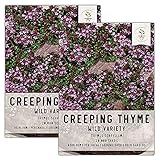
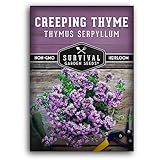

5 Comments
Can creeping thyme be Hydro Seeded on my hillside ?
I love the idea of a multi coloured lawn, could you recommend the best type of coloured thyme to use. Thank you
Jewels
QUESTION —
Hollie, What are the answers to these question ? I live in Albuquerque, NM and bought one plant and it is real small and I’m wondering if it will make it and look as beautiful as in some of the Ground Cover photos in the books and websites. A beautiful flow (river) of color. It looks so delicate. I’m concerned ??? Can you give me some tips/help? Our weather is dry and by June it will be real hot. I want the thick river of color. If Creeping Thyme is not for us out here, what do you recommend in many vibrant colors like the Creeping Thyme.
Actually, creeping thyme , i.e. Thymus serpyllum, is quite edible and rather tasty too when used for cooking or making tea. There’s a reason why it’s called mother of all thyme.
Will this grow at higher elevations? Arizona White Mountains. More specific Show Low. 6900 ft